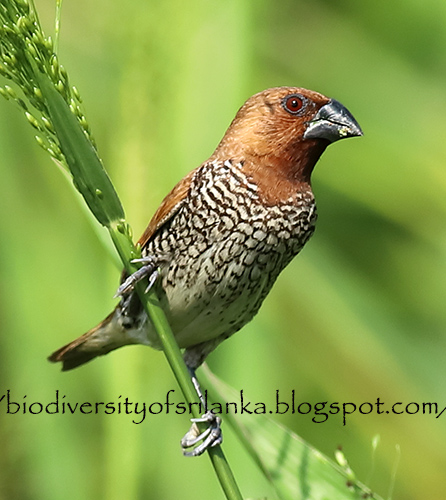ප්රධාන වශයෙන් පහත රට වියලි කලාපයේ මන්නාරම, යාපනය සහ හම්බන්තොට දිස්ත්රික්ක වල ශුෂ්ක වෙරල තීරයේ තෘණ භූමි, කුඹුරු සහ වෙනත් වගා බිම් වල එතරම් සුලභ නොවන ලෙස හමුවන දේශීය පක්ෂියෙකි. වියලි කලාපයේ සමහර ප්රදේශ වල ස්ථානීය වශයෙන් හුදකලා සමූහයන්ද ඇතැම් විට දැක ගත හැක. තෘණ බීජ, වී ආදි දේ ආහාරයට ගන්නා මෙම වී කුරුල්ලා බොහෝවිට 10-12 පමණ රංචු ලෙසින් හමුවන මුත් ඇතැම් අවස්ථා වලදී විශාල රංචු ලෙසින්ද දැකගත හැක. ගෙල සුදු වී කුරුල්ලා වසරේ දෙසැම්බර් සිට මාර්තු දක්වා කාලයේ වෙනත් වී කුරුල්ලන් මෙන් තෘණ භාවිතයෙන් ගෝලාකාර කූඩුවක් තනා එහි බිත්තර 4 සිට 6 දක්වා ප්රමාණයක් දමා අභිජනනය සිදු කරයි.
English Post >>Pages
- Home
- Flora of Sri Lanka
- Dragonflies & Damselflies of Sri Lanka
- Butterflies of Sri Lanka
- Freshwater Fishes of of Sri Lanka
- Amphibians of Sri Lanka
- Snakes of Sri Lanka
- Tetrapod Reptiles of Sri Lanka
- Mammals of Sri Lanka
- Resident Birds of Sri Lanka
- Migrant Birds of Sri Lanka
- Vagrant Birds of Sri Lanka
- Status Uncertain or Doubtful Birds of Sri Lanka
Thursday, December 25, 2025
Thursday, November 23, 2023
වී කුරුල්ලා/පිට සුදු වී කුරුල්ලා/නිතඹ සුදු වී කුරුල්ලා (Lonchura striata)
පහත රට ප්රදේශ වල සිට කඳුකරයේ මධ්යම උස් මට්ටම් දක්වා ගෙවතු, කුඹුරු, වනාන්තර, විවෘත වනලැහැබ්, වගාබිම් වල මෙන්ම ලඳු කැලෑ වලත් සුලභ ලෙස හමුවන දේශීය පක්ෂියෙකි. ජෝඩු වශයෙන් හෝ කුඩා රංචු වශයෙන් දිවි ගෙවන මෙම වී කුරුල්ලා වී ඇතුලු බොහෝ තණකොල විශේෂ වල බීජ ආහාරයට ගනී. පෙබරවාරි සිට මැයි දක්වා කාලයේ ප්රධාන වශයෙන් අභිජනනයේ යෙදෙන මුත් බොහෝවිට වසර පුරාම පාහේ පැටවුන් බෝ කිරීම සිදු කරයි. එක් පැත්තකින් ඇතුළු වීමට විවරයක් සහිතව ගසක් හෝ පඳුරක් මත තණකොල පත්ර උපයෝගි කරගනිමින් තනන බෝලයක හැඩැති කූඩුවක බිත්තර 4 ත් 6 ත් අතර ප්රමාණයක් දමා අභිජනනය සිදු කරයි.
English Post >>
Sunday, December 11, 2022
හිස කළු වී කුරුල්ලා/තෙපැහැ වී කුරුල්ලා (Lonchura malacca)
ප්රධාන වශයෙන් වියලි කලාපීය තෘණභූමි, පතන් බිම්, කුඹුරු සහ වගුරු බිම් වල දැකිය හැකි දේශීය පක්ෂියෙකි. නමුත් ස්ථානීය වශයෙන් වෙනත් දේශගුණික කලාප වලද හමුවේ. නැගෙනහිර පළාතේ වඩාත් සුලභව වාසය කරයි. කුඩා රංචු වශයෙන් දිවි ගෙවන මෙම වී කුරුල්ලන් වී සහ වෙනත් තණකොළ විශේෂ වල බීජ ආහාරයට ගනී. වසරේ මාර්තු සිට අගෝස්තු දක්වා කාලයේ පන් ගාලක හෝ මිටි පඳුරක තණකොළ පත්ර උපයෝගි කරගනිමින් සාදන බෝලයක හැඩය සහිත කූඩුවක බිත්තර 4 - 6 දක්වා ප්රමාණයක් දමා අභිජනනය කරයි.
English Post >>
Sunday, February 20, 2022
වී කුරුල්ලා/ළය කායුරු වීකුරුල්ලා/පුල්ලි වීකුරුල්ලා (Lonchura puntulata)
දිවයින පුරාම පාහේ තෘණ භූමි, ගෙවතු සහ කුඹුරු ආදියේ ඉතාමත් සුලභ දේශීය පක්ෂියෙකි. කුරුල්ලන් දහයක පමණ වූ රංචු වශයෙන් ජීවත් වන මෙම වී කුරුල්ලා වී සහ තෘණ බීජ ආහාරයට ගනී. වසර පුරාම පාහේ අභිජනනය කරන මුත් බොහෝවිට ඔක්තෝබර් සිට මැයි දක්වා කාලයේ බිත්තර සහ පැටවුන් සහිත කූඩු වැඩියෙන් හමුවේ. තණකොල පත්ර එකතු කර ගෝලාකාරව තනා ගන්නා කූඩුව ගසක් හෝ පඳුරක් මත තනයි. කටු සහිත දෙහි කුලයේ ශාක හෝ ඇතැම්විට පුවක් ගස් වල මල් කූඩු සැදීම සඳහා වැඩියෙන් යොදාගන්නා ආකාරය නිරීක්ෂණය කර ඇත.
English Post >>
Monday, September 22, 2014
Annotated checklist of vagrant Munias (Family: Estrildidae) recorded in Sri Lanka
Chestnut Munia (Lonchura atricapilla)
References:
Kotagama, S., Ratnavira, G. 2010. An illustrated Guide to the Birds of Sri Lanka. Field Ornithology Group of Sri Lanka, Colombo.
Legge V., 1880. A History of the birds of Ceylon 1983 second edition.
Saturday, November 16, 2013
වී කුරුල්ලා/පිට සුදු වී කුරුල්ලා/නිතඹ සුදු වී කුරුල්ලා [Wee Kurulla/Pita Sudu Wee Kurulla/Nithaba Sudu Wee Kurulla]/White-rumped Munia [White-backed Munia] (Lonchura striata striata)
Saturday, November 2, 2013
Tricoloured Munia [Black-headed Munia/Chestnut-Backed Munia] (Lonchura malacca)
Sunday, April 7, 2013
Indian Silverbill/White-throated Munia/ගෙල සුදු වී කුරුල්ලා [Gela Sudu Wee Kurulla] (Lonchura malabarica)

An uncommon breeding resident found in grasslands, paddy fields and cultivation mainly in arid coastal areas of low country dry zone in Mannar,






